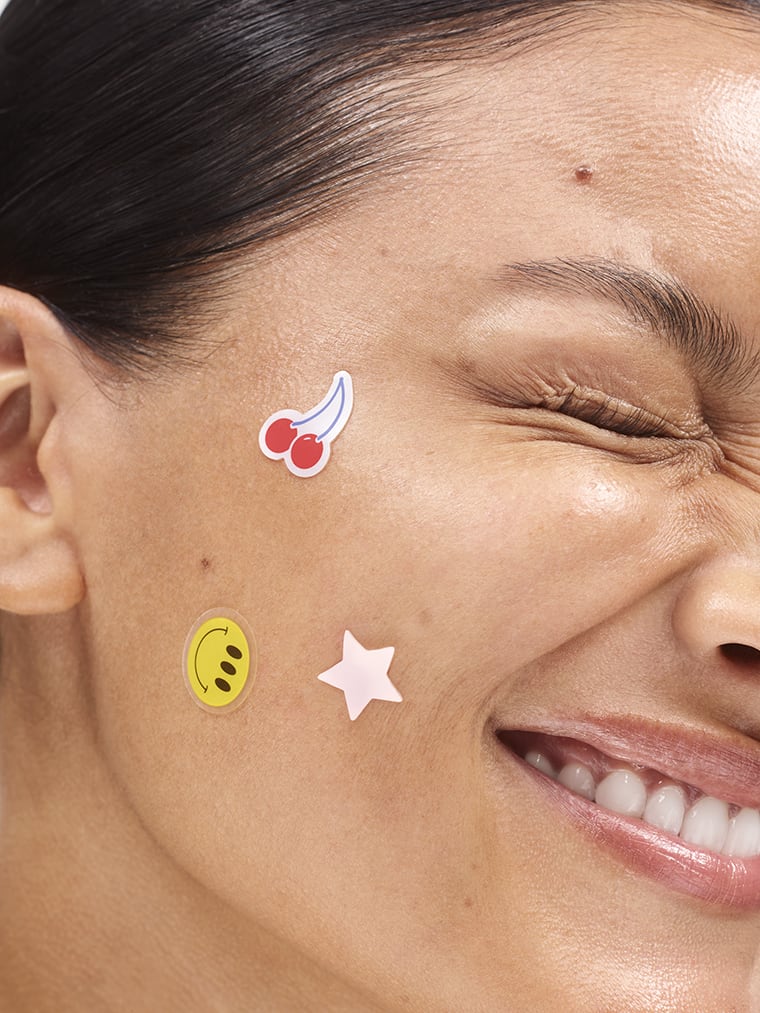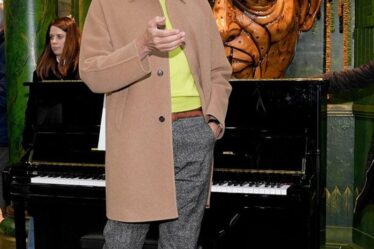
Glossier and Starface are bridging the generational gap.
The quintessential Millennial makeup and skin care brand is teaming up with the Gen-Z acne label to create a collection of pimple patches inspired by Glossier’s sticker sheets, which used to accompany each order. (Glossier stopped the practice in 2018.) The product, on sale on each brand’s e-commerce sites on Dec. 5, is a pink compact filled with 32 pimple patches of cherries, hearts, happy faces and stars — the same shapes of Glossier’s stickers. It even includes Glossier’s now signature catchphrase, “You Look Good” on a tiny mirror. Refill sheets are also for sale.
In its near-decade in business, Glossier has never partnered with another beauty line, nor has four-year-old Starface. But as two of the most prominent examples of beauty brands that have captured a generation’s attention, the team-up feels like a natural move for each company to take advantage of the other’s generational cache — and boost their own multigenerational appeal.
Since I first learned of the partnership a few months ago, I’ve been thinking about beauty brands’ ability to connect with consumers across age groups, from Boomers to Gen-Z (and eventually Gen Alpha), and whether multi-generational relevance is possible in beauty. Some might argue that in today’s breakneck, TikTok-driven trend cycle, attempting to create that kind of stickiness with so many different demographics is a fruitless endeavour; brands are better off catering to an algorithm. I disagree.
Great brands have always been able to appeal to a variety of age groups, whether it’s Nike, Apple or Patagonia. But beauty brands have historically had a harder time doing so because they’ve been less focussed on “values.” The beauty industry has always been youth-obsessed, selling anti-ageing potions and products designed to hide flaws even to those between the ages of 18 and 35 — but chasing young customers isn’t the same as being a youth-centric brand.
When I brought this topic up to an investor friend, he joked that the only multigenerational beauty brands are European. He had a point: Some of the lasting beauty brands have European roots, from the luxury-oriented Chanel and Dior, to French pharmacy staples such as Avene.
Despite being the poster child for Millennial beauty, Glossier has been able to make the transition to being a Gen-Z favourite, too — though luck has played a role. Glossier’s uncomplicated products have always been marketed as a way to embrace and enhance a wearer’s natural beauty, embodying the same mindset Gen-Z shoppers carry today. Launching in Sephora, its first retail partner, earlier this year, also helped Glossier further connect with Gen-Z: The #glossier hashtag has doubled from 1.2 billion views to 2.4 billion on TikTok since February. Partnering with Starface, which has captured the same sort of buzz Glossier had in its early days, only with Gen-Z, will likely help.
Glossier chief executive Kyle Leahy believes it can be a “forever brand.”
“We have the mother-daughter dynamic, and one of the passing of the generations,” she told me in a recent conversation. “Where the consumer is today, brands need to be more purpose driven, [they] have to have more value and meaning.”
Similarly, Drunk Elephant, a “clean beauty” pioneer that squarely appeal to older Millennials and Gen X when it launched in 2013, now is a favourite of both Gen-Z and Gen Alpha, thanks to influencer Alix Earle and the line’s now-viral D-Bronzi Anti-Pollution Sunshine Serum Drops.
Oftentimes, in beauty, brands may have a product that is a hit across age groups — think Clinique’s Black Honey — but that doesn’t mean these brand themselves are multigenerational.
“These older brands had very sticky customer bases, Boomers and Gen X, they never had to think outside of the box because they weren’t losing customers,” said Korinne Wolfmeyer, vice president and senior research analyst covering the beauty and wellness at Piper Sandler. “Now that their core customer is ageing out of beauty and Gen-Z is ageing in, we’re starting to see changes in who they talk to and how.”
E.l.f. is a good example of both a forever brand and a young brand; it was for young people when it debuted in 2004 and it still is in 2023. However, despite the company maintaining its fanbase of teenagers and twenty-somethings, they’ve had to evolve to meet the needs and desires of young people today, becoming one of the first beauty brands to go viral on TikTok with its “Eyes Lips Face” song back in 2019. It is also the number one ranked cosmetics brand on investment bank Piper Sandler’s annual Taking Stock with Teens survey, while still appealing to Millennials and Gen X.
Starface seems to be doing something similar. The brand is focussed on acne, which predominantly impacts young adults and its collaborations with Hello Kitty and Sesame Street speak to what Gen-Z loves now: nostalgia. 60 percent of its customers are Gen-Z and Gen Alpha, according to Starface president Kara Brothers.
Beyond being drug store staples, the acne brands of my Millennial teenage years, like Neutrogena and Clean and Clear, have little cultural relevance today. As such, Starface has been able to capture more of my demographic, too: 30 percent of its customers are Millennials. It probably will gain more of my age group now that it’s linked up with Glossier, which gives the indie line more credibility. Starface wants to appeal to anyone dealing with acne through a simple ethos: “showing up for yourself, and building confidence in moments that are otherwise tough,” said Brothers.
Leahy agreed that for a brand to be multigenerational it comes down to its community — both the one it is building today and the one it hopes to build tomorrow. Beauty brands, she said, need to do what Taylor Swift has done: Grow up with their core fans while capturing new ones along the way.
“It’s not just about being a consumer product that resonates across generations, it’s what you stand for,” she said.



